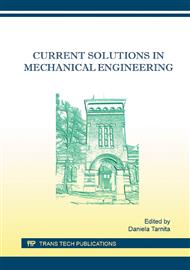p.61
p.65
p.71
p.75
p.79
p.85
p.91
p.95
p.101
Time Depending Friction in Bearing Mountings
Abstract:
The subjects of this paper are the existing bearing mountings of a testing rig for chain or belt drives. Friction in transmission without bearings is calculated by subtracting the bearing friction from the global friction. This is why it is of maximal importance in the correct evaluation of experimental measurements on the rig to have accurate data on the friction on bearings. After the period of running in, friction on the bearings is measured at certain intervals in time, but also depending on rotational speed, load and lubricating oil temperature.
Info:
Periodical:
Pages:
79-84
Citation:
Online since:
January 2016
Authors:
Keywords:
Price:
Сopyright:
© 2016 Trans Tech Publications Ltd. All Rights Reserved
Share:
Citation:


